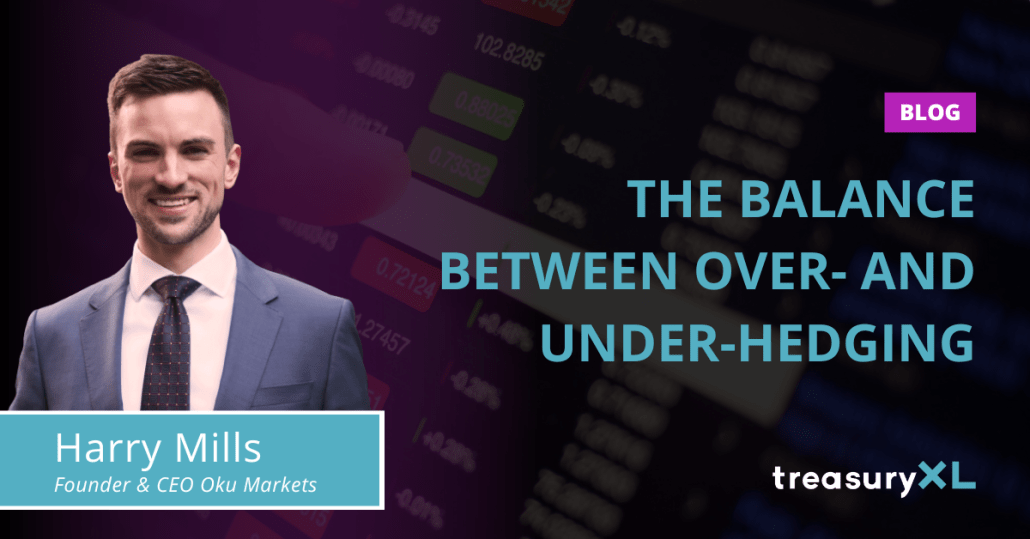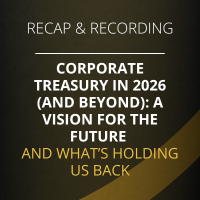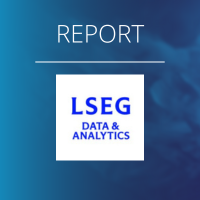In most circumstances, there isn’t really such a thing as a perfect hedge, especially when it comes to cash flow hedging of future forecasts!
In this short article, we’ll look into the murky world of over- and under-hedging, in other words hedging too much or too little.
Source: Oku Markets
Definitions
These are probably self-explanatory but, here goes…
- Under-hedging: when a company’s hedging activities are insufficient to adequately protect itself against adverse currency movements. These activities might be opposing currency cash flows generated through the normal course of business, for example matching revenues and costs in the same currency, or they might be the purchase of derivatives contracts (Forwards, Swaps, and Options) to hedge risk.
- Over-hedging: is the opposite of the above, whereby the hedged amount is greater than the notional exposure.
The Most Obvious Causes…
The most obvious reason for over- or under-hedging in the context of business currency risk management is inaccurate forecasting.
For example, take a UK business that sells products into Europe with a monthly revenue of around €500K…
- If the company were to hedge, say, €300K per month, it could be argued that this is under-hedging as the total notional exposure has not been hedged (1:1). However, I will add that it’s often desirable to hedge below 100% at whatever the optimal hedging ratio is for the company.
- Conversely, if the company were to hedge €600K per month, it’s fairly plain to see that this is a situation of over-hedging and, it’s likely the company won’t be able to fulfil the hedging trades and could incur costs of close-out or rolling.
In addition to inaccurate forecasting, economic and business changes can also disrupt hedging activities and result in hedging too much or too little. Changes in the location (and therefore currency) of suppliers or customers, government import/export tariffs, natural disasters, and sanctions are all real-world examples.
People are prone to making poor, emotional, or market-based decisions, which can leave a business with too much or too little hedging in place. If the company’s foreign exchange decision-maker thinks the market will move in their favour, they might hedge less than usual – big mistake! Or, perhaps they think they’re trading at the best opportunity and, they go big, hedging more (in volume and/or months forward) than their Policy or optimal hedging ratio dictates – another big mistake!
Devastating Derivatives
‘Derivative’ isn’t a dirty word, and neither is ‘Option’, but, there’s a trend in the market and a proliferation of FX salespeople flogging complex currency options and associated ‘multi-leg’ and/or ‘structured’ option products.
Some of these products include a feature called ‘leverage’ whereby the protected amount is less than the potentially obligated amount. Let’s look at the most basic leveraged option, the Ratio Forward:
- Like a traditional forward contract but, the protected amount is less than the obligated amount.
- It’s called a ‘ratio’ forward because the contract will have a protected: obligated ratio of say. 1:2 or 1:1.5.
- An example is a UK company buying products from the USA in dollars. They enter a Ratio Forward to buy $100,000 per month at a rate of $1.2500 and a leverage ratio of 1:2.
- This means that if on the Expiry Date of the contract(s) the market rate is lower (worse) than 1.2500, the company purchases $100,000 at 1.2500 but, if the market rate is higher (better), the company must purchase $200,000 at 1.2500.
- The Ratio Forward will offer a more favourable protection rate than the equivalent forward contract but, the company buying the product is, from the outset, either 50% under-hedged or, potentially 200% hedged by the time the Expiry Date(s) arrive.
So, with the example above, let’s see what happens to the company if they originally needed $100K or $200K:
- $100K Exposure: the company is 100% protected from downside risk, but if the market rises, they must buy 2x the amount of dollars they need, incurring close-out losses or rolling costs. If the market goes to $1.30 and they choose to sell the extra $100K, they will lose £3K!
- $200K Exposure: the company is only 50% protected from downside risk so, if the market falls then they will have secured 50% at 1.2500 but will be forced to trade at the spot rate for the other half, incurring losses. If the market is above 1.2500 then the company will deliver on the full amount.
A visual guide…
The chart below shows the total cost to the company with an underlying requirement to purchase $200,000, that purchased a Ratio Forward per the example above, at various GBPUSD spot rates.
You can see how in the event of a lower spot rate, the company’s purchase of $100,000 at 1.2500 and $100,000 at Spot results in a higher GBP cost (losses) due to the 50% under-hedging.

Risks of Over- and Under-Hedging
Under-hedging:
- Financial losses caused by adverse currency movements
- Profit margin and earnings volatility
- Forced to react and/or make market-based decisions
Over-hedging:
- Trading costs for rolling/extending hedging trades
- Losses from closing-out out of the money (OTM) positions
- Margin calls from holding excessive positions that move OTM
- Reduced competitiveness due to carrying forward unfavourable rates
- Fair value accounting losses (of derivatives) impacting earnings
Summary and How to Take Action
It’s very easy for a business to have a hedging position that is too much or too little compared to its underlying currency exposures. Bad decisions, inaccurate forecasting, and economic/business changes are the main culprits but, trading in speculative or leveraged derivatives is increasingly a major factor for companies.
Finding the perfect hedge is often an elusive goal. Over-hedging and under-hedging are real challenges that businesses face when seeking to protect themselves from the volatile currency markets. Here’s a brief summary of what we’ve learned and how you can take action to manage these risks effectively:
Key Takeaways:
- Inaccurate Forecasting: One of the most common causes of over- and under-hedging is inaccurate forecasting. Currency markets are influenced by numerous factors, making precise predictions challenging.
- Economic and Business Changes: Changes in supplier/customer locations, government policies, natural disasters, and sanctions can disrupt hedging strategies. Staying agile and adaptive is essential.
- Emotional or Market-Driven Decisions: Emotional decision-making or trying to time the market can lead to suboptimal hedging positions. It’s crucial to base hedging decisions on a clear strategy rather than market sentiment.
- Derivatives and Leveraged Options: Leveraged derivatives like Ratio Forwards can offer unique benefits but also introduce complexities. Understanding these instruments is essential before incorporating them into your risk management strategy.
Taking Action:
- Professional Guidance: Seek advice from experts in currency risk management. Their experience and insights can help you develop a tailored and effective hedging strategy.
- Risk Assessment: Regularly assess your currency risk exposure. Ensure it aligns with your business objectives and financial capabilities.
- Policy and Strategy: Establish clear currency risk management policies and strategies that consider your business’s unique needs and risk tolerance.
- Education and Training: Ensure your team is well-informed about currency risk and the hedging strategies in place. Education and training can help avoid costly mistakes.
- Review and Adapt: Currency markets are dynamic. Regularly review and adjust your hedging positions to align with changing circumstances.
Remember, there’s no one-size-fits-all solution when it comes to currency risk management. Each business is unique, and the optimal approach will depend on your specific circumstances.
Get in touch with treasuryXL expert Harry Mills to help find the perfect hedging strategy for your company’s unique needs. And he’ll do it all in a way that’s easy to understand and implement.
Harry Mills, Founder at Oku Markets












